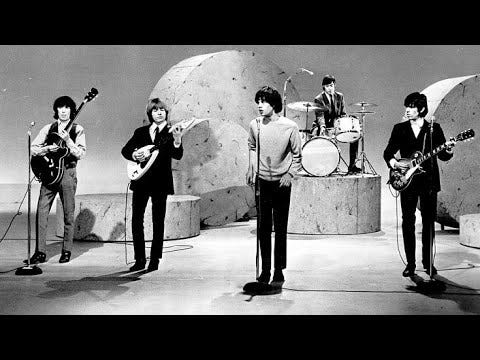The British Are Coming!
“Most white Americans only discovered the blues with the British invasion.” - Ronnie Wood
The Beatles kicked off the British Invasion period of rock history, but it wouldn’t be an “invasion” if they came alone, would it?
The long legacy of blues and skiffle in the U.K. was paying dividends, as the post-war period faded and Britain rebuilt. The concept of the “rock star” was evolving:
Blues Rock 🤘
Before it became Dad Rock, Blues Rock became a dominant force (during my dad’s childhood). The Rolling Stones formed in London with Mick Jagger, Keith Richards, Brian Jones, Charlie Watts, and Bill Wyman as a blues cover band. Mick and Keith initially bonded over albums by Muddy Waters and Chuck Berry. They even name the band after a Muddy song called, “Rollin’ Stone.”
The Rolling Stones were working on their songwriting chops, and met fellow Brits, John Lennon and Paul McCartney of The Beatles. John and Paul actually wrote one of the first Rolling Stones hits with the song "I Wanna Be Your Man" in 1963. The Rolling Stones recording of that Lennon/McCartney song was their first significant hit, shooting to number 12 on the UK charts.
In 1964, The Rolling Stones exploded on the American scene, bringing a grittier, bluesier sound on the Ed Sullivan Show — the same show that launched The Beatles into American stardom:
Fans of the Blues
On their first U.S. tour, the Stones set up meetings with their blues idols, connecting with Muddy Waters and Howlin’ Wolf at Chess Studios in Chicago. They excitedly booked Chess for some recording sessions, hoping that the American blues mojo might rub off on them.
And it did.
In 1965, they wrote (I Can’t Get No) Satisfaction, an all-time great rock song. One that will probably live forever.
And so here it is live. See how much of a difference a couple years of touring can make for artists?
Notice how the TV cameras are still using the close-up face shots they popularized with rock idols like Fabian? The cameramen knew what got the ratings!
The Beatles Weren’t Alone
Check out this hit by The Dave Clark Five. Notice the similarities to the early Beatles sound?
And check out how The Animals dressed on their Ed Sullivan appearance. Think it’s a coincidence that they captured some of The Beatles and British magic?
The same year (1964 was busy!), The Kinks brought an edgy sound, utilizing a type of chord called the power chord.
Power chords took away the major or minor thirds, so they were only two-note chords. A root note and a perfect fifth. Less emotion like happy or sad, easier to play, and more POWER. An ambiguous punch of sound!
Rock would make great use of these power chords, which are heavily used in the later genres of hard rock and punk:
Who’s on First?
Speaking of power chords… The Who burst onto the scene in 1965, making liberal use of these chords. Their drummer, Keith Moon, was a star in his own right, playing the drum kit with energy and chaos. Their Bassist, John Entwistle, was a lightening-quick virtuoso nicknamed Thunderfingers. Their guitarist, Pete Townshend, was prolific and studio-obsessed, and their vocalist, Roger Daltrey, was charismatic and always ready for a fistfight despite his good looks.
The Who came to be known as a “Mod Rock” band. The Mod subculture emerged in London during the late 1950s and early 1960s, featuring tailored suits, sleek scooters, loud music, and amphetamine-fueled nightlife. Here’s a short article on their fashion and how influential it was on the look of 60s if you’re into that sorta thang.
On the topic of style, listen to my podcast on vibe as it relates to the music realm:
The Yardbirds: Where Guitar Gods Were Made
Also in 1965, The Yardbirds broke out. The band served as an incubator for guitar heroes. Their ranks included Eric Clapton, Jeff Beck, and Jimmy Page, some of my favorite players of all time!
The Yardbirds also laid the groundwork for psychedelic rock! More on that next time.
America’s Folk Revival
Brit Rock might’ve dominated in the USA at this time, but folk was having its own revival… an electric one.
With great controversy, Bob Dylan picked up an electric guitar to sing his folk songs, a typically acoustic instrument genre. (Some music stores still call their acoustic section of the store “folk instruments.”)
Other acts like Simon & Garfunkel expanded pop music with the lyrical complexity of poetry and the everyday situations of folk. The Byrds from Los Angeles carried on Bob Dylan’s electrification and helped to establish the rock subgenre of Folk Rock.
Here they are with their cover of Dylan’s song, “Mr. Tambourine Man:”
And The Beatles were listening.
In the next post, we’ll talk about how The Beatles were inspired by folk then pushed rock into its next kaleidoscopic chapter: Psychedelic Rock.
Thanks for reading, internet friends,
Scoob






I loved learning about how blue rock was introduced and how it came to be popular. Additionally, the emotional aspect varies throughout the years which caught my eye. I never knew how the Rolling Stones and Beatles were connected! It intrigued me.
I got to hear the difference of rock music, how they all sound different and have their own vibe. But also to learn how The Rolling Stones got so popular. It’s nice to see how all these rock bands get their fame, got to say the kinks are the coolest.